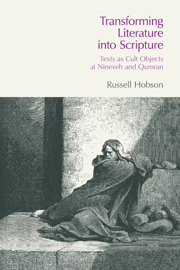Book contents
- Frontmatter
- Contents
- Acknowledgements
- Abbreviations
- 1 Authoritative Texts in the Hebrew and Cuneiform Traditions
- 2 Formulating a New Comparative Approach
- 3 Choosing the Right Texts
- 4 Study One: Enūma Anu Enlil Tablet 63
- 5 Study Two: Mul.Apin
- 6 Study Three: The Laws of Hammurabi
- 7 Study Four: Tablet XI of the Epic of Gilgamesh
- 8 Study Five: Mīs Pî
- 9 Study Six: Manuscripts of Pentateuchal Texts from Near the Dead Sea
- 10 Interpreting the Evidence
- Notes
- Bibliography
- Index of Ancient References
- Index of Authors
- Index of Subjects
4 - Study One: Enūma Anu Enlil Tablet 63
- Frontmatter
- Contents
- Acknowledgements
- Abbreviations
- 1 Authoritative Texts in the Hebrew and Cuneiform Traditions
- 2 Formulating a New Comparative Approach
- 3 Choosing the Right Texts
- 4 Study One: Enūma Anu Enlil Tablet 63
- 5 Study Two: Mul.Apin
- 6 Study Three: The Laws of Hammurabi
- 7 Study Four: Tablet XI of the Epic of Gilgamesh
- 8 Study Five: Mīs Pî
- 9 Study Six: Manuscripts of Pentateuchal Texts from Near the Dead Sea
- 10 Interpreting the Evidence
- Notes
- Bibliography
- Index of Ancient References
- Index of Authors
- Index of Subjects
Summary
The Text
The 63rd tablet of the series Enūma Anu Enlil is also known as the “Venus Tablet of Ammizaduga” because of the reference in the text to the “year of the golden throne,” a known eponym for the eighth year of the Old Babylonian ruler Ammizaduga. Ammizaduga was the fourth ruler after Hammurabi, and as such the origins of this text should probably be dated to around the mid-seventeenth century bce. Nevertheless, the largest number of copies comes from the first millennium bce. In relation to the rest of the series Enūma Anu Enlil, the 63rd tablet is unique in its specificity when referring to the conjunctions of Venus, in contrast to the tablets concerning other astral phenomena.
Reiner divides the text of the Venus Tablet into four sections, I–IV. The first section treats observations of the conjunctions between Venus and the sun in a chronological progression for the 21-year reign of Ammizaduga with the exception of his eighteenth year. In the second section 12 omens, apparently unconnected with Ammizaduga, are arranged in the order of the months. The very regular movements of Venus described in section II are obviously not based on real observations, but are more likely given as approximate dates to facilitate actual observations. Section III contains four omens that are also probably not related to those made during Ammizaduga's reign.
Information
- Type
- Chapter
- Information
- Transforming Literature into ScriptureTexts as Cult Objects at Ninevah and Qumran, pp. 35 - 46Publisher: Acumen PublishingPrint publication year: 2012
